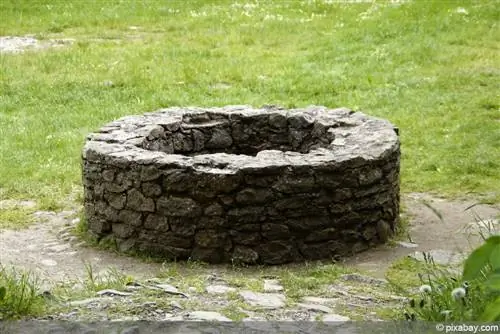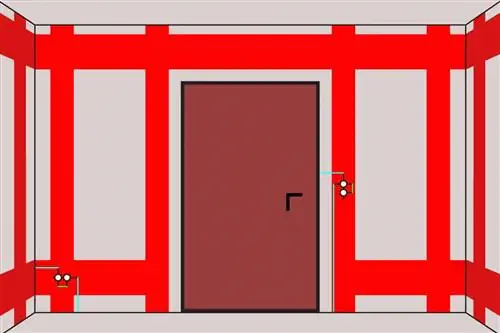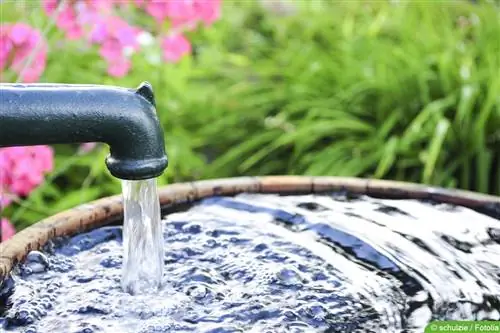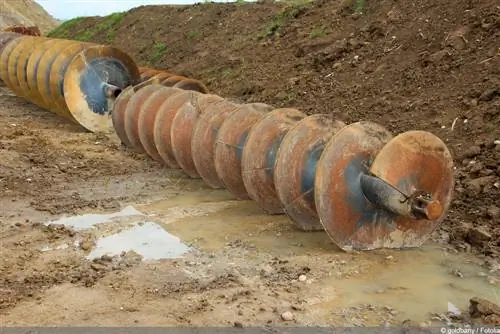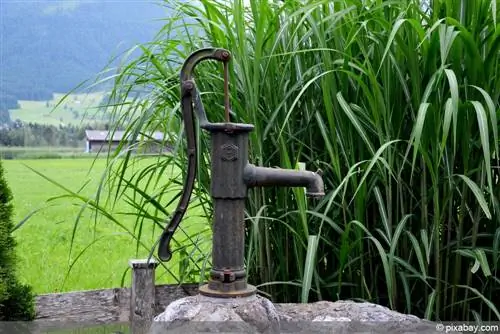- Author admin [email protected].
- Public 2023-12-17 03:39.
- Last modified 2025-01-24 12:45.
Is a drilled well worth it or will a ram well also work? Do you want to build it yourself or would you rather have it commissioned? Is it even worth investing in your own well? Is the area suitable for this? What are the regulations in the region? There are many issues that need to be clarified in advance before a materials list and a precise schedule of work steps can be created. So it's a big topic. Below is some help for the initial cost and process planning of drilling a well on your own.
Conditions
First, it must be clarified what the geological conditions are for drilling a well in the garden. This makes the fundamental decision as to whether it is even worth drilling a well, whether it is necessary to outsource the work or whether it is possible to build it yourself. The question of water requirements also plays an important role.
- Groundwater level
- Consistency of the soil
- Water requirements
- Authorities: permission, registration
The local groundwater levels can be found on the Internet or asked from the local waterworks. Unfortunately, not all federal states provide this information. In these cases you can ask the city. It's even easier to look for well owners in your neighborhood. Because it will largely depend on the depth of the groundwater which method makes the most sense.
In principle, it is permitted to drill your own well for the private purpose of supplying your home. In some federal states, however, these projects require notification and approval. The water from the well can be used to run a washing machine, flush toilets and of course supply water to the garden. Anyone who aims to save costs by drilling a well cannot avoid a calculation with the following parameters:
- Water consumption
- Acquisition costs
- Construction costs
- Operating costs
- Drinking water price
For it to be financially interesting and worthwhile to build your own well, you need a relatively high water requirement. This must then also be covered by the well or groundwater. Of course, there are also purely decorative, nostalgic reasons for building a fountain. But in this case too, it doesn't hurt to get an overview of the costs in advance. The maintenance effort and duration of a well must also be taken into account.
Tip:
It is definitely advisable to personally contact the relevant city or municipality office before planning. If the area is in a water protection zone or in a flood area, the (cost) effort becomes much more extensive.
Fountain Models
The costs depend largely on the desired or required fountain model. An overview of the three most common procedures:
Rammbrunnen
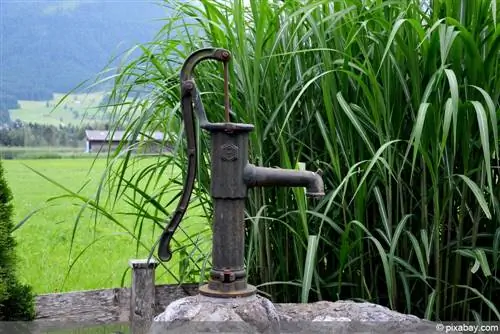
A ramming well is the most cost-effective option. It is well suited for groundwater depths of up to seven meters. The soil condition should be loose. The amount of water is sufficient to supply the garden, but it will hardly be enough to flush the toilets and the washing machine. In this process, a pointed pipe is rammed into the ground, either hydraulically or electrically. The material for this is cheap (approx. 100-200 EUR), plus the rental price for a ram or a simple sledgehammer. The follow-up costs must also be taken into account with this procedure. The filter at the bottom becomes clogged after a few years. Then you have to “ram” again somewhere else.
Shaft fountain
A shaft well is the most expensive option and is hardly feasible for a layperson. It makes sense for water depths of up to ten meters. Unlike a ram well, it can supply water for up to fifty years. This process costs around EUR 5,000 just for construction. A pump and other technology are not included.
Borewell
Now to the drilled well. This is the most common method for private well construction. For domestic use it can go a good 20 meters deep into the ground. The drilling itself can also be carried out by specialist companies. The price depends on the depth. Depending on the diameter of the borehole (usually 10 to 15 cm), you can expect costs of 100 to 300 EUR per meter. Added to this are the materials and technical accessories.
Drill your own well
Materials and equipment required:
- Auger
- gravel box
- Tripod with pulley
- Well material, well pump
These devices are only needed at the beginning and you may be able to borrow them from a neighbor or a hardware store. But what initially sounds cheap turns out to be more expensive than a new purchase. Because drilling the well can take several weeks.
Auger, gravel pump
A complete earth auger set new, for a depth of up to 10 meters, with a diameter of 13 mm, costs around 150 EUR. The same amount can be estimated again for the gravel box (gravel pump, pluncher). A plunscher is a steel pipe. It is dropped to the bottom and fills with sand. Then you pull it upwards with momentum and the lid at the bottom closes. The content is then pulled up.
Tripod
In addition there is the tripod or tripod with a force distributor. The tripod must be very stable because the gravel pump alone weighs up to 15 kg, plus the weight of the drilling material. Resourceful do-it-yourselfers can build their own tripod complete with winch and pulley. You can also improvise by using a sturdy three to four meter high two-part ladder. The rental fee for a tripod with a power converter is around EUR 50 per day.
Well pump
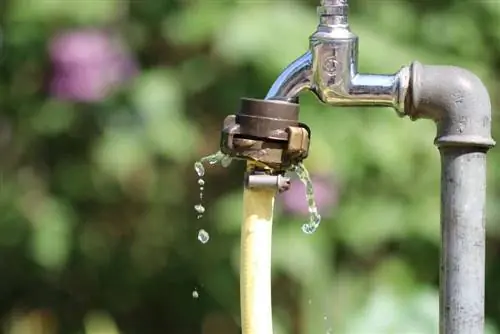
Depending on the well depth, effort and appearance, you choose a deep well pump, a suction pump or a hand pump. A hand pump requires a stone or concrete slab with a hole in the middle. Depending on the material and workmanship, they cost between 60 and 100 EUR. You can spend 200 to 500 EUR on a deep well pump. The suction pump is the least expensive option and is available for under 100 EUR.
Tip:
These devices are available used for around half the new price. Conversely, these devices can also be bought new and then sold again.
Schedule
- Determine a desired location for the fountain in the garden
- Pre-digging the hole with a spade
- Attach the auger and turn it clockwise until the spindle is screwed in
- Pull the drill and the soil upwards
- Continue drilling slowly and steadily, using the extensions, until you reach the groundwater
- Then insert a well pipe, preferably with a filter, and continue working with the gravel pump
- Put the borehole under water (if the existing water is not enough, add water from outside)
- Lower the gravel pump on the tripod and move it up and down
- Pull upwards and empty the contents
- Repeat this process up to 12 times
- So that the well pipe doesn't slide up, you can weigh it down or drive it down a little with hammer blows from time to time
- There should be approximately two meters of water in the borehole before the well pump comes into play
- Assemble the pump (depending on model)
- Now it's time to pump for several hours to get the water free of sand and to draw enough water into the well
Tip:
A time for drilling cannot be predicted. If you use a motor-driven, mobile drill, you can drill up to ten meters deep in a few hours. But it can also be done quite quickly manually if there are no large stones in the way. Then it may happen that you have to try again somewhere else.
Conclusion
Drilling a well, as you can see from the abundance of bullet points here, is not a project that can be implemented spontaneously. But with careful planning, valuable drinking water can be saved. And it is definitely a fantastic feeling to have your own water reservoir on your own property.

